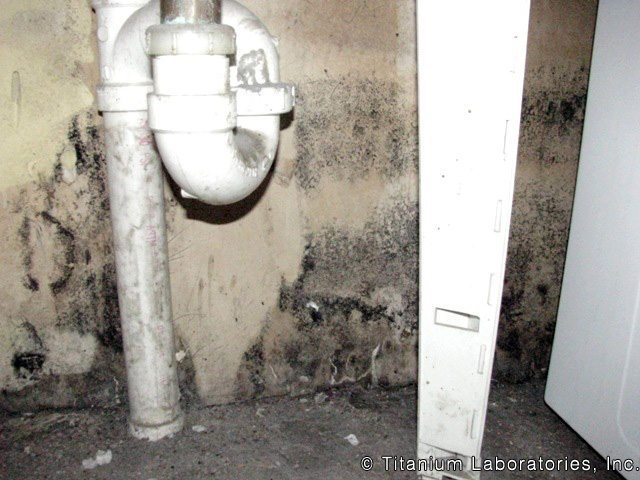Black mold symptoms are a result of exposure to indoor air that contains spores from toxic black mold.

Black mold growing on a sheetrock wall
About Black Mold
Black mold is formally named, “Stachybotrys”. It is a fungus that naturally grows on decayed plant matter and soil. However, black mold can find suitable substances in our indoor environments, thus posing structural and health problems. Black mold may begin to grow as a result of flooding, leaks, and high humidity. An indication of the possibility of black mold growth is black discoloration on water damaged building materials such as ceiling tiles, sheetrock, insulation, gypsum board, and wallpaper. Black mold can also grow on paper and textiles, such as upholstered furniture, draperies, carpeting, and other fabrics around your home.
Many different circumstances can cause black mold spores to dislodge from the materials where they grow, and infiltrate the indoor air environment. This is when black mold becomes potentially problematic to your health.
Black Mold and Indoor Air Environments
Black mold has the potential to produce toxins that when airborne may create an unhealthy indoor air environment. The toxins include:
- Cyclosporins
- Macrocyclic trichothecenes
- roridin E
- satratoxin F
- satratoxin G
- satratoxin H
- sporidesmin G
- trichoverrol
- verrucarin J
- Stachybotryolactone
Because of black mold’s potential to produce mycotoxins, stachybotrys, more commonly referred to as “black mold”, is linked to Sick Building Syndrome.
Exposure to Black Mold
Aside from inhaling indoor air that may be affected by mycotoxins produced from stachybotrys, contact may also occur through ingestion and / or skin exposure.1 This exposure may cause symptoms to the occupants of indoor spaces with indoor air affected by these mycotoxins. The elderly, infants, and individuals who are immunocompromised are at highest risk from exposure to indoor air that is affected by black mold. Also, individuals who are allergic to mold are at higher risk for allergic reactions.
Black Mold Symptoms
Exposure to black mold, specifically stachybotrys, can cause symptoms in different individuals which vary greatly depending on the individual. Symptoms that have been reported so far include, cold-like symptoms, rashes, conjunctivitis, sinusitis. It has also been reported to trigger asthma symptoms in certain individuals. Other symptoms related to black mold include fatigue, and lessened mental clarity. Still unproven, yet reported by some, is the possible link of stachybotrys atra to pulmonary hemosiderosis. (bleeding in the lungs of infants younger than 6 months old)2
The Truth About Toxic Black Mold
You will find a lot of information around the internet about “toxic black mold“. The truth of the matter is the presence of any mold has the ability to create health symptoms in individuals. All species of mold are considered to be “allergenic”, meaning that exposure to the spores may or may not cause an adverse health response to occupants. Some individuals are particularly sensitive, while others may experience no symptoms at all.
Although a mold allergy is the most common problem caused by exposure to mold, mold can cause illness without causing an allergic reaction. Mold can also cause infections, or irritant and toxic reactions. Infections caused by mold can cause a variety of problems from flu-like symptoms, to skin infections and even pneumonia.
An irritant reaction is caused when substances from molds called volatile organic compounds irritate the mucous membranes in the body. Symptoms of an irritant reaction are similar to an allergy and include eye irritation, runny nose, cough, voice hoarseness, headache and skin irritation. With a mold allergy, your symptoms will generally get progressively worse with each exposure to mold, while an irritant reaction doesn’t get worse.
A toxic reaction to mold is caused by eating, drinking or inhaling substances called mycotoxins. As with an irritant reaction, the symptoms of a toxic reaction may also include flu-like symptoms, eye and skin irritation, and breathing troubles. You may also experience headaches, nervousness, dizziness, difficulty concentrating and extreme fatigue if you’re having a toxic reaction to mold.3
Therefore, whether the mold growth in an indoor air environment is found to be stachybotrys, “toxic black mold”, or any other species of mold, it is always recommended to remove mold in a timely manner. When left to grow, a mold problem can become exponentially worse with time, causing more damage and more costly repairs in the end.
All Species of Mold are Considered “Allergenic”
Similar to pollen, mold carries the potential to create allergic reactions in certain individuals. These symptoms vary widely, and may range from barely-detectable to severe. Some allergic reactions to the presence of mold include cold-like symptoms (sneezing, runny nose / stuffy nose, itchy and / or watery eyes, itchy throat, coughing, & postnasal drip). If you experience any of these symptoms, we recommend that you consult with your doctor.3
Find out how Testing for Mold May Relieve Your Allergy Symptoms
How to Cure Black Mold Symptoms
Whether you are symptomatic due to black mold, or any mold growth in your home or building, the best way to ease the symptoms is to remove the mold growth. This is where a certified mold inspector can help you, by determining the following things:
- Is black mold, or any type of mold growing in your home or building?
- If so, what are the contributing factors that caused the mold growth in the first place? Is there high humidity, or an undetected leak somewhere?
- Has the presence of mold infiltrated the indoor air environment of your home or building?
- What is the safest and most effective way to remove the mold growth?
- How can you prevent a future mold infestation?
By removing mold growth from an indoor environment, most individuals find immediate relief to their mold-related symptoms.
If you are asking yourself, “Is it black mold?”, then contact Titnaium Laboratories today for a free consultation. Our Certified Mold Expert will help you determine if black mold may be causing you symptoms related to mold exposure.
Yesteryear’s Service. Tomorrow’s Technology. Call Titanium Today!
Test For Mold | Mold Test | Mold Testing | Black Mold | House Mold | Basement Mold
Mold Removal | Remove Mold | Mold Remediation
1 EMSL Analytical, Inc.
2 U.S. Department of Health & Human Services, Federal Occupational Health
3 Mayo Clinic – Mold Allergy














Leave a Reply